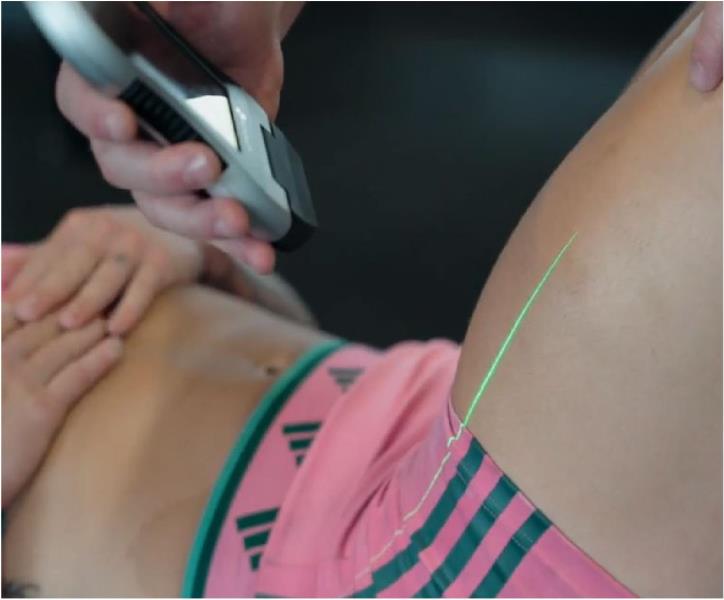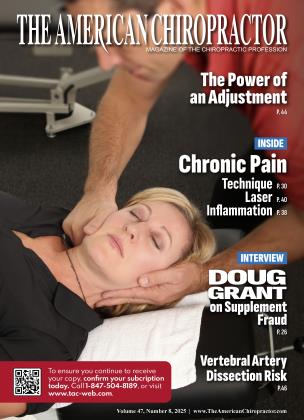Provide Long-Term Relief for Chronic pain Better Than NSAIDS and Opioids
August 1 2025 Kirk GairProvide Long-Term Relief for Chronic pain Better Than NSAIDS and Opioids
August 1 2025 Kirk Gair Dr. Gair using the GVL on Bethany Flores, #1 ranked in the USA and #4 in the World at the 2025 Crossfit Games World Championship. Severe, chronic low back pain kept her out of prior year’s competition, and laser got her pain free while enhancing performance
Dr. Gair using the GVL on Bethany Flores, #1 ranked in the USA and #4 in the World at the 2025 Crossfit Games World Championship. Severe, chronic low back pain kept her out of prior year’s competition, and laser got her pain free while enhancing performance
IF YOU TURN ON YOUR TV, you will constantly see “Big Pharma” ads for chronic pain. When I was in the UK to lecture on lasers, the European doctors commented on how strange it was for them to see these ads when they visited the US because that kind of direct patient marketing was illegal in Europe.
Americans are bombarded with ads, and then on the news we see the effects of the opioid epidemic created as the drugs wreak havoc on the lives of those who become addicted. Thus, it is paramount to provide an alternative to the pharma-based “solution.”
Fortunately, research shows that chiropractic1 and high-energy lasers are a more effective and safer alternative for treating pain. This was clear to the Russians as early as 1974 when they found 635 nm, pulsed, red lasers to be so effective for many conditions that they made them part of state-sponsored standard medical care.2
I was a coauthor on a literature review published in the Journal of Orthopedics and Rheumatology, where we compared the efficacy of 635 mn red lasers to red light LEDs, NSAIDS, and opioids for chronic low back pain, plantar fasciitis, and other conditions. Our findings suggested that lasers are more effective and safer than the drug-based approach and that laser triggered tissue repair and long-term benefits while drugs did not.3
Laser also outperformed red light therapy by an average of six to seven times greater results for reducing pain and increasing ROM and showed greater long-term benefits. Our findings suggest that lasers should be used before a drug-based approach, especially in patients at risk for addiction. If you add chiropractic adjustments along with the lasers, your efficacy is even greater.
This is where many readers may get confused by laser marketing myths. Unfortunately, many sales reps and ads will tell you that red lasers are only effective for superficial conditions even though high-quality, doubleand quadruple-blind studies prove they have impacts in deeper tissues. Most reps have no idea that there is a difference in how high-energy and low-energy wavelengths work.
“The easiest analogy to understand this is UV light when it hits our skin and only penetrates a few microns.”
High-energy wavelengths are below 730 mn and include violet, green, and red. They all have electron volt (eV) energy above 1.7 eV, ranging from 3.1 eV for violet, 2.4 for green, and 1.9 for red. These eV levels trigger electron jumps that create photochemical and photo signaling reactions, which work differently than the low eV/high wattage infrared lasers that rely on stimulating molecular rotations and vibrations and depend on direct tissue penetration. Wavelengths longer than 730 nm all have eV below the 1.7 eV threshold for electron jumps and direct photochemical reactions.4
The easiest analogy to understand this is UV light when it hits our skin and only penetrates a few microns. It then triggers vitamin D production that affects deep bone health, global inflammation levels, and immune function. Babies with jaundice are placed under a blue light to have an impact on the liver despite not directly penetrating it.
Top Russian laser researcher Sergey Moskvin has shown that high eV red lasers can also impact deep tissues by being applied over blood vessels for conditions such as chronic bronchial asthma.5
Many doctors think violet, green, and red lasers won’t impact a disc in the low back due to their depth but were never told about the independent studies that showed these wavelengths can trigger reactions in the extracellular matrix modifying enzymes to stimulate annulus repair and have an impact in degenerative disc disease to reduce pain and trigger repair.6
These same wavelengths were shown to impact chronic renal fibrosis when studied at the University of Chicago, Illinois Medical Center. So while you cannot advertise or say that your lasers are treating their kidneys, it is wonderful to know that applying these wavelengths to a chronic low back pain patient will support disc repair and can favorably impact their kidneys.7
For chronic low back pain, we were able to show in double-blind, placebo-controlled studies of 635 red laser versus red light that hands-free, unattended 20-minute sessions twice a week were able to reduce pain by 58%.8 Even more impressive, subjects had an average reduction of an additional 17.48% at the 12-month follow-up, bringing the average improvement to over 75%.9 This was with a 3 diode scanning laser only, so if you add chiropractic adjustments, the results will be even greater.
Similar results were achieved for plantar fasciitis, but that only took six 1 O-minute sessions twice a week. Our research led to FDA clearances for these powers and wavelengths for both conditions. Recently, class 2 nonthermal lasers have received a full-body clearance for postoperative pain and inflammation. I have seen this speed up surgical recoveries between 30-70% faster than projected timelines.10
Dr. Robert Silverman and I had our research on green and violet lasers for chronic neck and shoulder pain published in a peer-reviewed journal, which led to the first FDA clearance for these wavelengths for chronic pain. This is the highest electron volt combination available, and we compared the efficacy to red/violet combo, dual red, and red light.
Our findings showed a whopping 81% of subjects had a minimum 30% pain reduction in a single, hands-free, 13-minute session (six minutes each side, one minute top of head). These subjects all had a minimum duration of five years of chronic pain and a 5/10 level.
They did a home questionnaire follow-up at 24 and 48 hours, and it showed that their pain levels were reduced even more at the 48-hour mark than they were immediately after treatment. The average pain improvement at 48 hours was 65% and 32 degrees ROM. Red light showed no long-term benefits as subjects returned to baseline.11
The key takeaway here is that combining lasers with chiropractic gives you a huge edge over your competitors and will create a word-of-mouth practice. I have not had to advertise in over a decade because of how excited my patients are to tell everyone.
Best of all, this therapy does not chew up a lot of your time or your staff’s time. While I do teach advanced neuro rehab protocols that take more learning and time to do, all of these pain approaches allow you to do unattended treatments that are highly effective and free up your time.

Dr. Kirk Gair has been in private practice since 1999 and using Erchonia cold lasers since 2004. He has treated elite athletes, including Super Bowl and MLB champions, as well as national record holders. His expertise in cold laser therapy and training in functional medicine and neurology attract patients from across the U.S. Dr. Gair has been featured in the documentary The Thyroid Secret and the bestselling book Hashimoto’s Protocol by Dr. Izabella Wentz, as well as on major health platforms and podcasts. To contact Dr. Gair, call (626) 922-1414, email [email protected], or visit LaserChiropractic.net.
1. Bronfort G, Evans R, Anderson AV, Svendsen KH, Bracha Y, Grimm RH. Spinal manipulation, medication, or home exercise with advice for acute and subacute neck pain: a randomized trial. Ann Intern Med. 2012 Jan 3:156(1 Pt l):l-10. doi: 10.7326/0003-4819-156-1-201201030-00002. PMID: 22213489.
2. Moskvin SV. Low-level laser therapy in Russia: history, science and practice. J Lasers Med Set. 2017 Spring;8(2):56-65. doi: 10.15171/jlms.2017.11. Epub 2017 Mar 28. PMID: 28652897; PMCID: PMC5474383.
3. Jacob J, Chris B, Cesar A L, Kirk G, Brandon B, et al. Efficacy of 635nm red low-level laser on nociceptive musculoskeletal pain compared to NS AIDS, opioids, and other light sources. Ortho & Rheum Open Access J. 2020; 17(2): 555960. DOI: 10.19080/OROAJ.2020.17.555960.
4. Moriyama Y, Moriyama EH, Blackmore K, Akens MK, Lilge L. In vivo study of the inflammatory modulating effects of low-level laser therapy on iNOS expression using bioluminescence imaging. Photochem Photobiol. 2005 Nov-Dec;81(6): 1351-5. doi: 10.1562/2005-02-28-RA-450. PMID: 16076245.
5. Moskvin SV, Khadartsev AA. Methods of effective low-level laser therapy in the treatment of patients with bronchial asthma (literature review). Biomedicine (Taipei). 2020 Mar28;10(l):l-20. doi: 10.37796/22118039.1000. PMID: 33854908; PMCID: PMC7608842.
6. Hwang MH, Kim KS, Yoo CM, Shin JH, Nam HG, Jeong JS, Kim JH, Lee KH, Choi H. Photobiomodulation on human annulus fibrosus cells during the intervertebral disk degeneration: extracellular matrix-modifying enzymes. Lasers Med Sei. 2016 May;31(4):767-77. doi: 10.1007/sl0103016-1923-x. Epub 2016 Mar 17. PMID: 26987527.
7. O'Connor M, Patil R, Yu J, Hickey R, Premanand K, Kajdacsy-Balla A, Benedetti E, Bartholomew A. Mesenchymal stem cells synergize with 635, 532, and 405 nm laser wavelengths in renal fibrosis: a pilot study. Photomed Laser Surg. 2016 Nov;34(ll):556-563. doi: 10.1089/ pho.2015.4025. Epub 2016 May 31. PMID: 27244220.
8. Trevor S B, Travis M S, Steve S. Two randomized, double-blind, placebo-controlled trials evaluating the efficacy of red 635nm low level laser for the treatment of low back pain. Ortho & Rheum Open Access J. 2021; 17(3): 555964 doi: 10.19080/OROAJ.2021.17.555964.
9. Berry TS, Quameri PJ, Roche G, Sammons TM. Low-lever laser therapy for treating low Back Pain: 12-month follow-up. J Pain Relief. 2020:9:347.
10. Pinto, V. Review of section 510(k) premarket notification of intent for K211186 [letter], U.S. Food & Drug Administration. 2021 October 22. Available from: thttps://www.accessdata.fda.gov... K211186.pdf
11. Sammons T, Gair K, Silverman RG, Shanks S. Assessing the impact of high photon energy wavelengths on the treatment of chronic neck and shoulder pain. Evid Based Complement Alternat Med. 2023 Oct 4:2023:6672019. doi: 10.1155/2023/6672019. PMID: 37829623; PMCID: PMC 10567292.
 View Full Issue
View Full Issue









